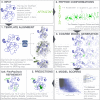InterPep2: global peptide-protein docking using interaction surface templates
- PMID: 31917413
- PMCID: PMC7178396
- DOI: 10.1093/bioinformatics/btaa005
InterPep2: global peptide-protein docking using interaction surface templates
Abstract
Motivation: Interactions between proteins and peptides or peptide-like intrinsically disordered regions are involved in many important biological processes, such as gene expression and cell life-cycle regulation. Experimentally determining the structure of such interactions is time-consuming and difficult because of the inherent flexibility of the peptide ligand. Although several prediction-methods exist, most are limited in performance or availability.
Results: InterPep2 is a freely available method for predicting the structure of peptide-protein interactions. Improved performance is obtained by using templates from both peptide-protein and regular protein-protein interactions, and by a random forest trained to predict the DockQ-score for a given template using sequence and structural features. When tested on 252 bound peptide-protein complexes from structures deposited after the complexes used in the construction of the training and templates sets of InterPep2, InterPep2-Refined correctly positioned 67 peptides within 4.0 Å LRMSD among top10, similar to another state-of-the-art template-based method which positioned 54 peptides correctly. However, InterPep2 displays a superior ability to evaluate the quality of its own predictions. On a previously established set of 27 non-redundant unbound-to-bound peptide-protein complexes, InterPep2 performs on-par with leading methods. The extended InterPep2-Refined protocol managed to correctly model 15 of these complexes within 4.0 Å LRMSD among top10, without using templates from homologs. In addition, combining the template-based predictions from InterPep2 with ab initio predictions from PIPER-FlexPepDock resulted in 22% more near-native predictions compared to the best single method (22 versus 18).
Availability and implementation: The program is available from: http://wallnerlab.org/InterPep2.
Supplementary information: Supplementary data are available at Bioinformatics online.
© The Author(s) 2020. Published by Oxford University Press.
Figures








